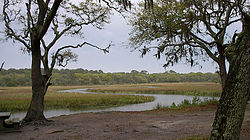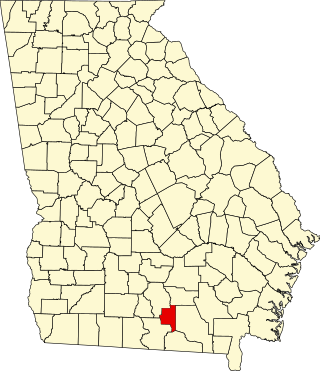
Lanier County is a county in the south central portion of the U.S. state of Georgia. As of the 2020 census, the population was 9,877. The county seat and only incorporated municipality is Lakeland. The county is named after the Georgia poet Sidney Lanier.

Glynn County is located in the southeastern part of the U.S. state of Georgia. As of the 2020 census, the population was 84,499. The county seat is Brunswick. Glynn County is part of the Brunswick, Georgia Metropolitan Statistical Area.

Brunswick is a city in and the county seat of Glynn County in the U.S. state of Georgia. As the primary urban and economic center of the lower southeast portion of Georgia, it is the second-largest urban area on the Georgia coastline after Savannah and contains the Brunswick Old Town Historic District. At the 2020 U.S. census, the population of the city proper was 15,210; the Brunswick metropolitan area's population as of 2020 was 113,495.

Sidney Clopton Lanier was an American musician, poet and author. He served in the Confederate States Army as a private, worked on a blockade-running ship for which he was imprisoned, taught, worked at a hotel where he gave musical performances, was a church organist, and worked as a lawyer. As a poet he sometimes used dialects. Many of his poems are written in heightened, but often archaic, American English. He became a flautist and sold poems to publications. He eventually became a professor of literature at the Johns Hopkins University in Baltimore, and is known for his adaptation of musical meter to poetry. Many schools, other structures and two lakes are named for him, and he became hailed in the South as the "poet of the Confederacy". A 1972 US postage stamp honored him as an "American poet".

William Vaughn Moody was an American dramatist and poet. Moody was author of The Great Divide, first presented under the title of The Sabine Woman at the Garrick Theatre in Chicago on April 12, 1906. His poetic dramas are The Masque of Judgment (1900), The Fire Bringer (1904), and The Death of Eve. His best-known poem is "An Ode In Time Of Hesitation," on the Spanish-American War; others include "Gloucester Moor," "On A Soldier Fallen In The Philippines," "The Brute," "Harmonics", "Until the Troubling of the Waters," "The Departure," "How The Mead-Slave Was Set Free," "The Daguerreotype," and "The Death of Eve." His poems everywhere bespeak the social conscience of the progressive era (1893-1916) in which he spent his foreshortened life. In style they evoke a mastery of the verse-craft of his time and also the reach and depth derived from his intensive studies of Milton and of Greek Tragedy.

Paul Hamilton Hayne was a nineteenth-century Southern American poet, critic, and editor.

Emilia Lanier, néeAemilia Bassano, was an English poet and the first woman in England to assert herself as a professional poet, through her volume Salve Deus Rex Judaeorum. Attempts have been made to equate her with Shakespeare's "Dark Lady".

Lady Mary Wroth was an English noblewoman and a poet of the English Renaissance. A member of a distinguished literary family, Lady Wroth was among the first female English writers to have achieved an enduring reputation. Mary Wroth was niece to Mary Herbert née Sidney, and to Sir Philip Sidney, a famous Elizabethan poet-courtier.
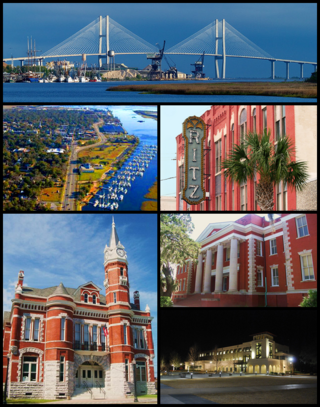
The Golden Isles of Georgia consist of barrier islands, and the mainland port cities of Brunswick and Darien, on the 100-mile-long coast of the U.S. state of Georgia on the Atlantic Ocean. They include St. Simons Island, Sea Island, Jekyll Island, Little St. Simons Island, Sapelo Island, Blackbeard Island, Historic Darien and Historic Brunswick.

The Sidney Lanier Bridge is a cable-stayed bridge that spans the Brunswick River in Brunswick, Georgia, carrying four lanes of U.S. Route 17. The current bridge was built as a replacement to the original vertical-lift bridge, which was twice struck by ships. It is currently the longest-spanning bridge in Georgia and is 480 feet (150 m) tall. It was named for poet Sidney Lanier. Each year, there is the "Bridge Run" sponsored by Southeast Georgia Health System when the south side of the bridge is closed to traffic and people register to run the bridge.
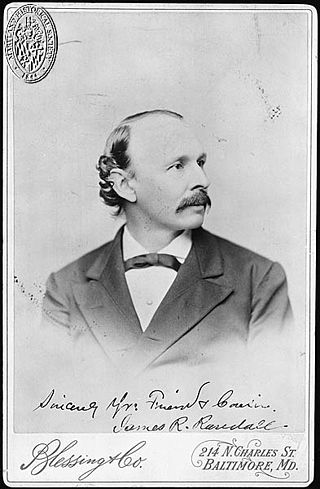
James Ryder Randall was an American journalist and poet. He is best remembered as the author of "Maryland, My Maryland".

Glynn Academy (GA) is an American public high school in Brunswick, Georgia, United States, enrolling 1,900 students in grades 9–12. Along with Brunswick High School, it is one of two high schools in the Glynn County School System. Glynn Academy offers technical, academic, and Advanced Placement programs and is accredited by the Georgia Department of Education and the Southern Association of Colleges and Schools. The school has consistently been ranked among the top public high schools in the United States by Newsweek.
Nationality words link to articles with information on the nation's poetry or literature.

Father John Banister Tabb was an American poet, Roman Catholic priest, and professor of English.
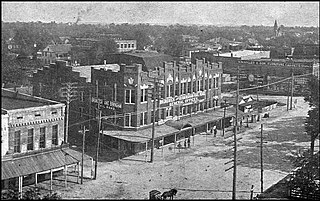
The recorded History of Brunswick, Georgia dates to 1738, when a 1,000-acre (4 km2) plantation was established along the Turtle River. By 1789, the city was recognized by President George Washington as having been one of five original ports of entry for the American colonies. In 1797, Brunswick's prominence was further recognized when it became the county seat of Glynn County, a status it retains to this day. During the later stages of the Civil War, with the approach of the Union Army, much of the city was abandoned and burned. Economic prosperity eventually returned, when a large lumber mill was constructed in the area. By the late 19th-century, despite yellow fever epidemics and occasional hurricanes, business in Brunswick was thriving, due to port business for cotton, lumber, naval stores, and oysters. During this period, Brunswick also enjoyed a tourist trade, stimulated by nearby Jekyll Island, which had become a posh, exclusive getaway for some of the era's most influential people. World War I stimulated ship building activity in Brunswick. But it was not until World War II that the economy boomed, when 16,000 workers were employed to produce ninety-nine Liberty ships and "Knot" ships. During the war, Brunswick's Glynco Naval Air Station was, for a time, the largest blimp base in the world. Since the end of World War II, the city has enjoyed a period of moderate economic activity, centered on its deep natural port, which is the westernmost harbor on the eastern seaboard. In recent years, in recognition of a thriving local enterprise, Brunswick has declared itself to be the "Shrimp Capital of the World".

"Break, Break, Break" is a poem by Alfred, Lord Tennyson written during early 1835 and published in 1842. The poem is an elegy that describes Tennyson's feelings of loss after Arthur Henry Hallam died and his feelings of isolation while at Mablethorpe, Lincolnshire.

The Sidney Lanier Cottage is a historic cottage on High Street in Macon, Georgia, that was the birthplace of poet, musician, and soldier Sidney Lanier. Sidney Lanier Cottage was purchased by the Middle Georgia Historical Society in 1973, and opened to the public in 1975. Until 2021, the Sidney Lanier Cottage served as a museum, event space, and home of the Lanier Center for Literary Arts. Though now a private residence, it is still occasionally used for events by the Historic Macon Foundation.

A Masque of Poets is an 1878 book of poetry published in the United States. The book included several poems, all published anonymously, including one by Emily Dickinson. Names were not included in the compilation so that the original works could be judged on their own merit without any preconceived notions about the poet.

Lanier's Oak is a historic Southern live oak tree in Brunswick, Georgia. It is named after poet Sidney Lanier.

The Sidney Lanier Monument is a public monument in Atlanta, Georgia, United States. Located in Piedmont Park, the monument consists of a bust of Sidney Lanier, a notable poet from Georgia. The monument was dedicated in 1914.
